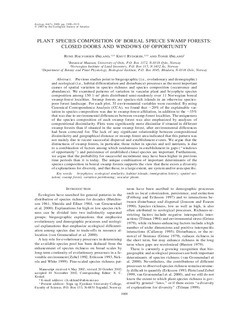| dc.contributor.author | Økland, Rune Halvorsen | |
| dc.contributor.author | Rydgren, Knut | |
| dc.contributor.author | Økland, Tonje | |
| dc.date.accessioned | 2007-09-03T13:04:45Z | |
| dc.date.issued | 2003 | |
| dc.identifier.citation | Okland, R.H., Rydgren, K., & Okland, T. (2003). Plant species composition of boreal spruce swamp forests: Closed doors and windows of opportunity. Ecology, 84(7), 1909-1919. | |
| dc.identifier.issn | 0012-9658 | |
| dc.identifier.uri | http://hdl.handle.net/11250/149311 | |
| dc.description.abstract | Previous studies point at biogeographic (i.e. evolutionary and demographic) and ecological (i.e. habitat differentiation and disturbance) processes as the most important causes of spatial variation in species richness and species composition. We examined patterns of variation in similarity of vascular plant and bryophyte species composition among 150 1-m2 plots distributed semi-randomly over 11 Norwegian boreal swamp-forest localities that were species-rich islands in an otherwise species-poor forest landscape. For each plot, 53 environmental variables were recorded. By using CCA analyses, we found that c. 20% of the explainable variation in species composition was due to swamp-forest affiliation, in addition to the c. 35% that was due to environmental differences between swamp-forest localities. The unique component of the species composition of each swamp forest was also emphasised by analyses of floristic dissimilarity: plots were significantly more floristically dissimilar if situated in different than if situated in the same swamp forest, even after environmental differences had been corrected for. The lack of any significant relationship between floristic dissimilarity and geographical distance or swamp-forest area indicated that this pattern was not mainly due to demographic processes. We argue that the floristic distinctness of swamp forests, in particular those richer in species and soil nutrients, is due to a combination of factors among which randomness in establishment in infrequently occurring gaps ( ‘windows of opportunity’) are likely to be important. The unique combination of important determinants of the species composition found for boreal swamp forests supports the view that there exists a diversity of explanations for diversity and that these, to a large extent, are system- and/or area-specific. | en |
| dc.format.extent | 560775 bytes | |
| dc.format.mimetype | application/pdf | |
| dc.language.iso | eng | en |
| dc.publisher | Ecological Society of America | en |
| dc.subject | Bryophytes | en |
| dc.subject | Ecological similarity | en |
| dc.subject | Habitat islands | en |
| dc.subject | Immigration history | en |
| dc.subject | Spatial variation | en |
| dc.subject | Swamp forest | en |
| dc.subject | Variation partitoning | en |
| dc.subject | Avdeling for naturfag | |
| dc.title | Plant species composition of boreal spruce swamp forests: closed doors and windows of opportunity | en |
| dc.type | Journal article | en |
| dc.type | Peer reviewed | |
| dc.source.pagenumber | 1909-1919 | en |
| dc.source.volume | 84(7)2003 | en |
| dc.source.journal | Ecology | en |
